#Namo Narayana
Explore tagged Tumblr posts
Link
Rajinikanth, Mohanlal, Shivarajkumar, Jackie Shroff, Ramya Krishnan, Vinayakan, Tamannaah Bhatia, Sunil, Vasanth Ravi, Yogi Babu, Kishore Kumar G., Nagendra Babu, Jaffer Sadiq, G. Marimuthu, Vtv Ganesh, Redin Kingsley, Namo Narayana,
#Rajinikanth#Mohanlal#Shivarajkumar#Jackie Shroff#Ramya Krishnan#Vinayakan#Tamannaah Bhatia#Sunil#Vasanth Ravi#Yogi Babu#Kishore Kumar G.#Nagendra Babu#Jaffer Sadiq#G. Marimuthu#Vtv Ganesh#Redin Kingsley#Namo Narayana#Aranthangi Nisha#Mahanadhi Shankar#Sunil Reddy#Mirnaa#Padam Kumar#Makrand Deshpande#Karate Karthi#Rithvik Jothi Raj#Arshad#Saravanan#Sugunthan#Kalaiyarasan#Billy Muralee
0 notes
Text

🌿 Om Namo Narayana 🌿
🌿Om Shreem Kleem Mahalaxshmi Namaha 🌿
7 notes
·
View notes
Text
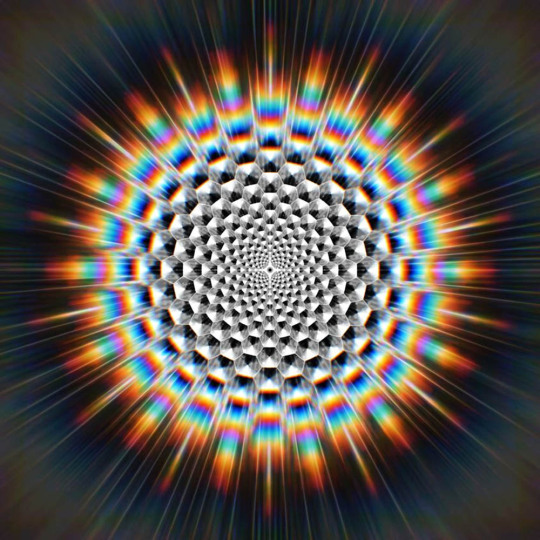
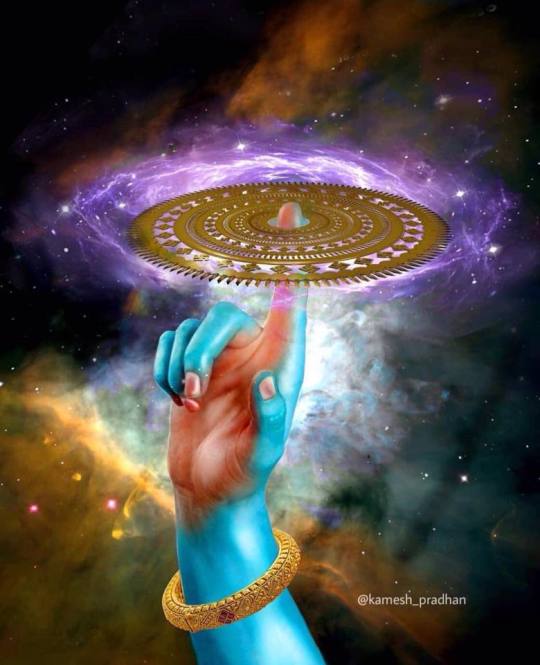
Sudarshana Chakra
(The Wheel of Auspicious Vision)
The Sudarshana Chakra legend that is recounted is the one in which Vishwakarma, the architect of Gods diminished the shine of Lord Surya, the Sun God. Vishwakarma's daughter was married to Surya, but could not go near Him as it was difficult to endure His scorching brilliance and heat. So Vishwakarma had to reduce the intensity of the Sun by churning him. This created a Sun dust from which Vishwakarma created a few powerful golden objects, including the Sudarshana Chakra. Other weapons were Trishula and Pushpak Vimaan which were respectively the weapons of Lord Vishnu, Shiva and Lord Kuber. Lord Vishnu holding Sudarshana Chakra is worshipped as Chakrathazhwar, Sage of the wheel.
When Lord Krishna took incarnation, Shri Vishnu gave him this chakra which he could use immediately at any time, it was his own property. During Samudra Manthan, Lord Vishnu used the Sudarshan chakra to cut through the demon Swarbanu who then became Rahu and Ketu. During Daksha yagna it was used by Shri Vishnu to cut burnt Satis body into 51 parts which fell on earth and became Shakti Peeths, holy places for worshipping goddess Shakti.
1- The Sudarshan Chakra has 108 serrated blades, and has the capability to travel several million yojanas (1 Yojana = 8 kms) at a blink of an eye.
2- It is not thrown at anybody, rather, by willpower, it is sent against the enemy. It has tremendous occult and spiritual power to destroy everything.
3- Once out of finger, it chases the enemy and never returns without achieving intended results.
Om Namo Narayana -- Jai Shri Vishnu
6 notes
·
View notes
Text
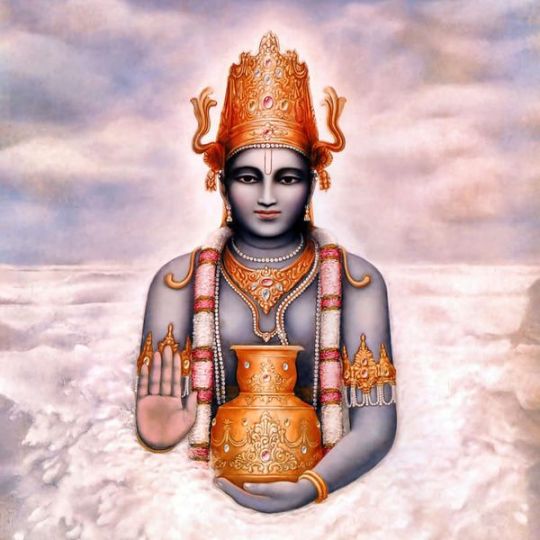
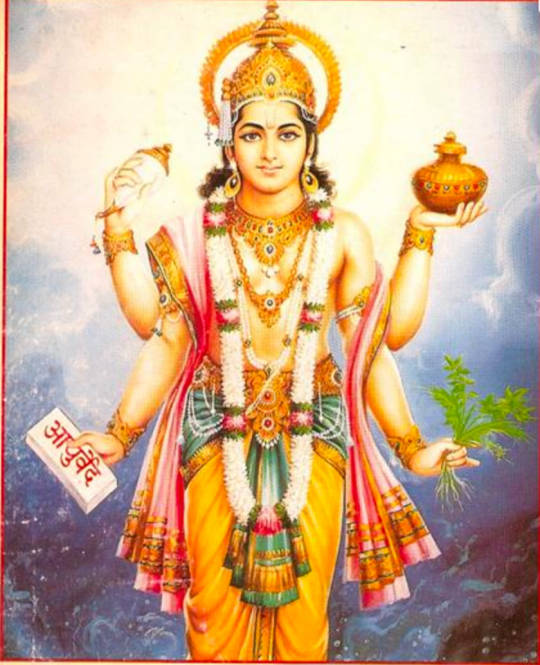
Prayers to Lord Dhanvantri for health, healing, and protection against physical or mental disease.
Lord Dhanvantri blesses His devotees with health and longevity.
Om Namo Bhagavate Maha Sudharshana Vasudevaya Dhanvantaraye
Amrutha Kalasa Hasthaaya Sarva Bhaya Vinasaya Sarva Roka Nivaranaya
Thri Lokya Pathaye Thri Lokya Nithaye Sri Maha Vishnu Swarupa Sri Dhanvantri Swarupa
Sri Sri Sri Aoushata Chakra Narayana Swaha
6 notes
·
View notes
Text
Rahu mahadasha secrets part 4/101
Hari Om Namo Narayana! I know I know! Haven’t written about ‘Rahu ji‘ in a while. Well 3 posts coming out in quick succession this week as I bring this series up to speed. Actually I’ve been very busy working on my book ‘Decoding Rahu’ that comes out as a paperback in July. If you would like to be notified when it is released, you can register here. So, what’s the 4th elusive fact that I have…

View On WordPress
#how to overcome rahu#jay Kaushal#north node of the moon#rahu antardasha#rahu in vedic astrology#rahu mahadasha#rahu mahadasha secrets#understanding rahu#vedic astrology articles
10 notes
·
View notes
Video
youtube
"Om Namo Narayana" is a mantra from Hinduism that holds significant spiritual and devotional importance. It is composed of three primary elements: "Om," "Namo," and "Narayana." Let's break down the mantra's components and their meanings:Om: "Om" (also spelled as "Aum") is a sacred syllable, often referred to as the "sound of the universe." It is considered the most fundamental and powerful mantra in Hinduism and other Indian religions. "Om" represents the primordial sound of creation, the essence of ultimate reality, and the interconnectedness of all existence.Namo: "Namo" is a Sanskrit word that can be translated as "I bow to" or "I honor." It signifies a deep reverence and submission. When used in a mantra, it expresses humility and devotion to the divine or the object of worship.Narayana: "Narayana" is a name of the deity Lord Vishnu in Hinduism. Vishnu is one of the principal deities in the Hindu pantheon, known as the preserver and sustainer of the universe. "Narayana" can be understood as a form of address to Lord Vishnu and symbolizes the divine presence, protection, and cosmic harmony.So, when the mantra "Om Namo Narayana" is chanted or repeated, it can be understood as an expression of profound devotion and surrender to the divine presence represented by Lord Vishnu. The mantra encapsulates the idea of acknowledging the universal essence (Om), offering respect and humility (Namo), and connecting with the energy of divine preservation and harmony (Narayana).Chanting or meditating on this mantra is believed to invoke spiritual blessings, promote inner peace, and cultivate a deep sense of connection with the divine. It's often used in religious rituals, meditation practices, and devotional singing as a way to attune oneself to higher consciousness and tap into the qualities associated with Lord Vishnu.
3 notes
·
View notes
Text
Who is radha?
Lord Krishna is the Supreme Personality of Godhead (īśvaraḥ paramaḥ kṛṣṇaḥ). He is the cause of all the causes (sarva-kāraṇa-kāraṇam). He is the origin of all the devatas (aham ādir hi devānāṁ). All the Vedas glorify Lord Krishna alone (vedaiś ca sarvair aham eva vedyo). He is the unborn Lord that takes on many appearances in this world (ajayamano bahudha vijayate). He is the antaratma (inner controller) of all the living entities (akhila-dehinām antarātma-dṛk).
Lord Krishna is Nirguna- completely beyond the material gunas (harir hi nirguṇaḥ sākṣāt). Although He is Nirguna, He is the abode of all-auspicious qualities (guṇāṁś ca doṣāṁś ca mune vyatīta samasta-kalyāṇa-guṇātmako hi).
Lord Krishna has no form yet His beautiful form (anirdesya vapuh) enchants even the cupid. He has no hands and feet (apāṇi-pāda) yet the Gopis are embraced by His serpentine arms and He runs on His tender feet, in fear of Mother Yashoda. He has no eyes, yet His sidelong glances destroy the patience of the millions of Gopis. Lord Krishna is Satyam, Jnanam, Anantam Brahma. He is all-pervading Brahman, yet He is found crawling in the corner of the courtyard of the house of Nanda Maharaja (satyaḿ-jñānam-anantaḿ nityam anākāśaḿ paramākāśaḿ goṣṭha prāńgaṇarińgaṇalolam anāyāsaḿ paramāyāsam).
Through Lord Krishna’s various expansions of expansions of expansions, countless universes are created, maintained, and ultimately destroyed (yasyāṁśāṁśāṁśa-bhāgena viśvotpatti-layodayāḥ). Following His order, Lord Brahma creates the universe and following His order, Lord Hara destroys the creation (sṛjāmi tan-niyukto ’haṁ haro harati tad-vaśaḥ). He, however, is completely independent (abhijñaḥ svarāṭ).
All the Vedic literatures describe Him as Supreme Brahman (kṛṣṇaṁ paraṁ brahma). The form of this Supreme Brahman is human-like (gūḍhaṁ paraṁ brahma manuṣya-liṅgam). That humanlike form is eternally a son of Nanda Maharaja and Mother Yashoda. He cannot be reached by exercising our minds, words, and consciousness. (namo girāṁ vidūrāya manasaś cetasām api)
Lord Krishna is the beginning, middle, and end of all the Vedas, Puranas, Itihasas, etc (ādāv ante ca madhye ca hariḥ sarvatra gīyate). In fact the very word ‘’OM’’, with which all the Vedic Mantras begin, is the sound representation of Lord Krishna (praṇavaḥ sarva-vedeṣu). All the various names found in the Vedas such as Rudra, Indra, Agni , Soma, Mitra, etc glorify Lord Krishna alone (namani sarvani yam vishanti tam vai vishnum paramam udaharanti).
Lord Krishna is the master of all the Yogis and the Brahmavadis who want to experience the bliss of Kaivalya or Nirvana (kaivalya-nirvāṇa-sukhānubhūtiḥ). The son of Devaki can offer all types of Mukti (bhagavān devakī-putraḥ kaivalyādy-akhila-pradaḥ).
What then to speak about the supreme glories of His dear devotees? Lord Krishna becomes the ultimate giver of bliss for His ananya bhaktas who reject even the Kaivalya or impersonal Mukti (na gṛhnanti vinā mat-sevanaṁ janāḥ), which are generally held in high regard by the many. In His form of Lord Narayana, He is eternally a master of Lakshmi Devi. He is the master of all the innumerable Shaktis headed by Sri, Bhu, Nila, etc.
In the various Yajnas, Lord Krishna is glorified with eloquent prayers such as follows
yaṁ brahmā varuṇendra-rudra-marutaḥ stunvanti divyaiḥ stavair vedaiḥ sāṅga-pada-kramopaniṣadair gāyanti yaṁ sāma-gāḥ dhyānāvasthita-tad-gatena manasā paśyanti yaṁ yogino yasyāntaṁ na viduḥ surāsura-gaṇā devāya tasmai namaḥ Unto that personality whom Brahmā, Varuṇa, Indra, Rudra, and the Maruts praise by chanting transcendental hymns and reciting the Vedas with all their corollaries, pada-kramas and Upaniṣads, to whom the chanters of the Sāma Veda always sing, whom the perfected yogīs see within their minds after fixing themselves in trance and absorbing themselves within Him, and whose limit can never be found by any demigod or demon — unto that Supreme Personality of Godhead I offer my humble obeisances.- Srimad Bhagavatam 12.3.1
Now, there is one special cowherd girl who brings this Supreme Personality of Godhead, Lord Krishna, completely under Her control. Her name is Sri Radha.
A very special cowherd girl, the dust of whose lotus feet Krishna reveres with great humility, is Sri Radha. A very special cowherd girl, who makes Krishna mad and faint in ecstasy is Sri Radha. A very special cowherd girl who is Krishna’s highest pleasure potency is known as Sri Radha. A very special cowherd girl, who is nondifferent from Krishna, just as the shakti (energy) and shaktiman (energetic) are nondifferent and just as the sunlight and sun are nondifferent, is known as Sri Radha
#hare krsna#krsna#krishan#lord krishna#hare krishna#krishna#iskontemple#iskon#astrology numerology vedicastrology#vedic astrology#lordkrishna#lordvishnu#lordram#lordshiva#harekrishna#vedas#vedic astro observations#astrology#vedic jyotish online
2 notes
·
View notes
Text
Paush Putrada Ekadashi 2024|पौष पुत्रदा एकादशी 2024
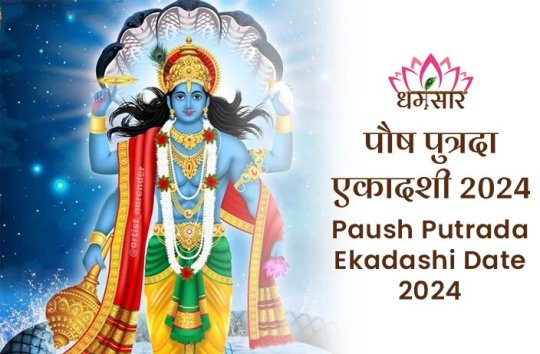
Date, auspicious time and importance| तिथि, समय, शुभ मुहूर्त व महत्व
Putrada Ekadashi is one of the most important and prestigious fast festivals dedicated to Lord Vishnu. The rituals of this festival are usually performed by married couples. Married women wishing to have a child observe a fast on Putrada Ekadashi and also observe various rituals associated with this festival to seek the divine blessings of Lord Vishnu.
Ekadashi of Shukla Paksha of Paush month is called Paush Putrada Ekadashi (Putrada Ekadashi 2024). On this day, Lord Vishnu, who holds the Sudarshan Chakra, is worshipped. It is believed that observing this fast leads to the birth of a child, hence it is called Pausha Putrada Ekadashi. It is believed in the scriptures that due to the effect of this fast, the children are also protected.
Let us know, the Paush Putrada Ekadashi date, auspicious time, and significance in the year 2024-
Paush Putrada Ekadashi Date 2024|पौष पुत्रदा एकादशी तिथि 2024
The fast of Paush Putrada Ekadashi is observed on the 11th day of Shukla Paksha of Paush month. This fast of Paush Putrada Ekadashi, this year is on Sunday 21 January 2024.
Putrada Ekadashi 2024 Shubh Muhurat (Putrada Ekadashi 2024 auspicious time)|पुत्रदा एकादशी 2024 शुभ मुहूर्त
The auspicious time of Putrada Ekadashi 2024 is as follows-
Ekadashi start time - 20 January 2024, from 07:26 pm
Ekadashi closing time - 21 January 2024, till 07:26 pm
Ekadashi fasting breaking time - 22 January 2024, 07:14 am to 09:21 am
Significance of Pausha Putrada Ekadashi| पौष पुत्रदा एकादशी ��ा महत्व
Putrada Ekadashi fast is especially observed by married couples who do not have children and wish to have children.
Fasting on Putrada Ekadashi also provides happiness, health, happiness, wealth and prosperity to the devotees. Lord Vishnu protects all those devotees who worship him with utmost faith, devotion, and rituals.
As we can understand from the name of Putrada Ekadashi (Putrada Ekadashi Significance), it means "the one who gives a son." According to Hindu scriptures, Lord Vishnu blesses those observing this wonderful fast with all the happiness and fulfills their desired wishes.
Mantras of Lord Vishnu |भगवान विष्णु के मंत्र
Chanting these mantras of Lord Vishnu on the day of Ekadashi will bring peace and prosperity to your life and will help you in getting the blessings of Lord Vishnu. This Vishnu mantra is as follows-
1. Om Namo Bhagwate Vasudevay..!!
2. Om Namo Narayana..!!
3. Shantakaram Bhujagashayanam Padmanabham Suresham,
Vishwadharam is like the sky, the clouds are auspicious..!!
Lakshmikantam Kamalanayanam Yogibhirdhyanagamyam,
Vande Vishnu Bhavabhayaharam Sarvlokaikanatham..!!
#Paush Putrada Ekadashi 2024#Paush Putrada Ekadashi#Putrada Ekadashi 2024#Lord Vishnu#Shukla Paksha#Sudarshan Chakra#Paush month#Shubh Muhurat#Significance#Mantras of Lord Vishnu
1 note
·
View note
Text
Hare krishna hare ram
Om namo narayana
#hindutemple#hindu chants#blogger#just a qoute guy#anime and manga#history#health & fitness#illustration#movies#music#nature#food#Spotify
3 notes
·
View notes
Text
Puri Jagannath temple - checklist
|| Om Namo Narayanaya ||
The Jagannath temple at Puri is one of the largest, most visited and most wonderful spiritual centres of our country. It is one of the Char Dham. (4 prominent temples, one in each direction) The temple is dedicated to Sri Jagannath, a form of Lord Krishna along with his elder brother Balarama and younger sister Subhadra.
The temple complex is large (~10 acres) in area. It contains over 50 sub-shrines, ranging from medium-sized temples to small, often unnoticed shrines. Most of us hurriedly rush to have Darshan at the main temple, missing other temples/places in the temple complex. This is a list of all the important shrines in the Puri Jagannath temple complex, with a brief description of each. A printout of this would be handy while visiting the temple. (Gadgets are not allowed inside the temple premises)
Temple visiting procedure
Pay obeisances to the Aruna Stambha before entering the temple through the East gate.
Have Darshan of Patita Pavana. Don't fail to notice Hanuman and Narasimha Swami next to him.
Climb the 22 steps. Place your feet on Yama Dandam on the 5th step while entering, and don't set foot on it while exiting.
Offer salutations 🙏 to Nila Chakra and the flag. If possible, witness the flag changing ceremony.
Do a Pradakshina and have Darshan at the following temples.
Finally, enter the main temple and prostrate before Jagannath. Have Darshan
Exit the temple, go to Anand Bazar and have Prasadam.
Alternatively, you can first follow steps 1 to 4, visit the main temple, and visit the other shrines later. (Basically interchange steps 6 and 5)
List of temples/places
Aruna Stambham (pillar) - originally from Konark, was brought here to protect from invasions. (The following temples are inside the East Gate)
Patita Pavana - Life-size replica of the main Jagannath deity; Can be viewed from a distance.
Fateh Hanuman
Hatta Narasimha (The following are to the left of 22 steps)
Kashi Vishwanath
Abhaya Narasimha (The following are in front of Jagannath temple)
Lakshmi Narasimha
Agneshwar Mahadev
Satya Narayana Swami (The following are under the banyan tree)
Vatrapatra Sayi
Markandeshwar
Vata Ganesh
Vata Jagannath - Miniature of the original Jagannath deity
Vata Mangala Devi - Kshetra Palika (guardian)
Indrani Devi (The following are near the South gate)
Simhachala Narasimha
Shadbhuja Chaitanya Mahaprabhu
Barabhai Hanuman
Purana Narasimha
Budhi Ma
Kshetra Palaka Shiva
Kitchen - one of the largest, oldest and busiest kitchens in the world where Prasadam is cooked. (The following are in/near Mukti Mandapam)
Mukteswara Siva
Adi Narasimha
Surya Yantra
Rohini Kund (well)
Ananta Shayanam
Chandi Devi
Dakshin Ghar - A room that contains all the Utsava Vigrahas. (small deities) The prominent deity is Madan Mohan, Lord Krishna playing the flute. (The following are behind Jagannath temple)
Vimala Devi
Gopeswara Mahadev
Makhan Chor Krishna
Ekadasi Devi
Kanchi Ganesh
Tandava Ganesh
Nisha Narasimha (The following are near West gate)
Char Dham Mandir
Kanapata Hanuman
Gupta Narasimha
Church Bell (These are on the same lane as Vimala Devi temple. Take a left turn)
Bhuvaneswari Devi
Sarasvati Devi
Shashti Devi
Gayatri Devi
Savitri Devi (Deities from 41 to 45 are in a single temple.)
Yoga Narasimha
Nila Madhav (The following temples are on the North of Jagannath temple)
Sri Lakshmi Devi
Surya Narayana - Deity brought from Konark to protect from invasions
Chaitanya Mahaprabhu's footprints (The following temples are towards the North gate)
Koil Vaikuntam
Vaikuntheswara
Tapasvi Hanuman
Uttara Durga
Shitala Devi
Sona Kua (golden well)
Pataleshwar
Ishaneshwar
Nava Narasimha temples
Hatta Narasimha - East Gate (Near Patita Pavana)
Abhaya Narasimha - left side of 22 steps
Lakshmi Narasimha - Front side of the main temple
Simhachala Narasimha - Near south gate
Purana Narasimha - South gate
Mukti Narasimha - Mukti Mandapam
Nisha Narasimha - Behind Jagannath temple (have to climb steps)
Gupta Narasimha - in a cellar near Kanapata Hanuman
Yoga Narasimha - Near the deity of Gayatri Devi
Hanuman temples
Fateh Hanuman - East Gate (Near Patita Pavana)
Barabhai Hanuman - South (Near Simhachala Narasimha)
Kanapata Hanuman - West
Tapasvi Hanuman - North (Near Kovil Vaikuntam)
This list would not be possible without the information given by Sri Nanduri Srinivas in his videos. He has compiled detailed information from research as well as from the local priests and presented it in his videos. (In Telugu language)
|| Om Namo Narayanaya ||
0 notes
Text

ॐ तत्पुरुषाय विद्महे सुवर्णपक्षाय धीमहि तन्नो गरुडः प्रचोदयात्
oṃ tatpuruṣāya vidmahe suvarṇa pakṣāya dheemahi tanno garuḍaḥ pracodayāt
Om Namo Bhagavate Garudaaye
Om Namo Narayana
ॐ
2 notes
·
View notes
Text
Dasavataaram in Bronze: The Ten Avatars of Narayana in Saanskrit and Tamil Nadu Art

Introducing Dasavataaram, a stunning collection showcasing the ten divine Avatars of Narayana. From the powerful Narasimha to the wise Rama, each Avatar is beautifully crafted to capture the essence of Saanskritam and Tamil Nadu’s rich tradition. These exquisite pieces, including Narasimhaswamy with Lakshmidevi in 6-inch brass, Krishna in 6-inch bronze, Sri Maha Vishnu with Lakshmi in 3-inch brass, and Sri Varahaswamy with Lakshmi Devi in 6-inch bronze, are perfect for adding a touch of divinity to your space. Ideal gifts for Mother's Day, Father's Day, weddings, or housewarmings, these masterpieces invite you to embrace tradition and celebrate the divine. Gift yourself or a loved one the timeless beauty of Dasavataaram. Om Namo Narayanaaya. Shop Now and bring home these divine treasures!
0 notes
Text
10 philosophical teachings of Sri Ramanuja!
தமிழில்
If you think that the idols in the temple are made of stone, you will not know God.
Don't help others expecting a reward.
As soon as you see the tower of the temple, bow your hands and bow down.
Don't associate with those who complain about others, if you associate with others, his character will come to you.
Om namo narayana chant this mantra daily.
Understanding brings happiness!
Do not say no to offerings in the temple.
Take hold of God's steps and your sins will melt away.
Slowly crawl the temple premises.
Compassion is something everyone should have.
Worshiping His servants is higher than worshiping God.
ஸ்ரீ ராமானுஜர் அருளிய 10 தத்துவ போதனைகள்!
கோவிலில் உள்ள மூர்த்திகள் கல் சுதை ஐம்பொன்னால் ஆனது என்று எண்ணினால் கடவுள் தெரியமாட்டார்.
பலனை எதிர்பார்த்து பிறருக்கு உதவி செய்யாதே.
கோவிலின் கோபுரத்தை பார்த்த உடனேயே கைகூப்பி வணங்கு.
பிறரை குறை கூறுபவரிடம் பழகாதே மீறி பழகினால் அவரது குணம் உனக்கு வந்து விடும்.
ஓம் நமோ நாராயணா இந்த மந்திரத்தை தினமும் சொல்லு.
புரிதல் இருந்தாலே மகிழ்ச்சி பூரிக்கும்!
கோவிலில் கொடுக்கும் பிரசாதங்களை வேண்டாம் என்று சொல்லாதே.
கடவுளின் திருவடிகளை பற்றிக் கொள் உனது பாவம் கரைந்து விடும்.
கோவில் பிரகாரத்தை மெதுவாக வலம் வரவும்.
புலனடக்கம் என்பது ஒவ்வொருவரிடமும் இருக்க வேண்டும்.
கடவுளை வணங்குவதை விட அவரது அடியார்களை வணங்குவது உயர்வானது.

0 notes
Text

#Self Realization Fellowship#Paramahansa Yogananda#Ananda#Ananda Sangha Worldwide#Kirtan#Bhajan#Harinam#Kriya Yoga#Mahavatar Babaji
1 note
·
View note
Video
youtube
Namo Namo Sri Narayana | Perumal Songs | Puratasi Special | Tamil Devoti...
0 notes
